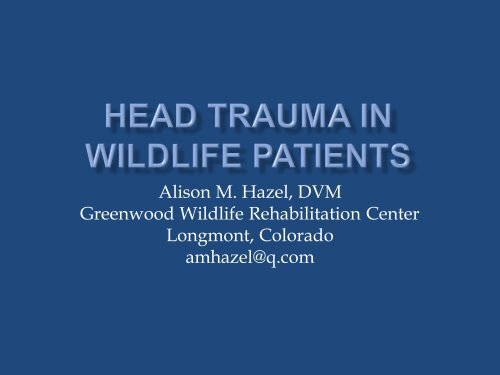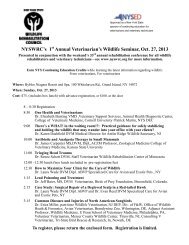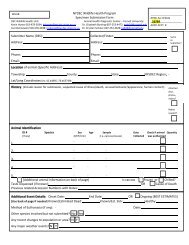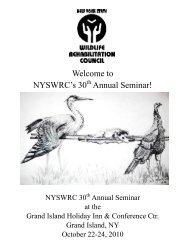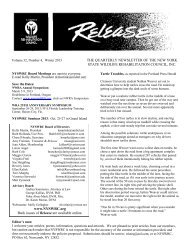1. Head Trauma in Wildlife Patients
1. Head Trauma in Wildlife Patients
1. Head Trauma in Wildlife Patients
Create successful ePaper yourself
Turn your PDF publications into a flip-book with our unique Google optimized e-Paper software.
Alison M. Hazel, DVM<br />
Greenwood <strong>Wildlife</strong> Rehabilitation Center<br />
Longmont, Colorado<br />
amhazel@q.com
• <strong>Head</strong> trauma is one of most common <strong>in</strong>juries<br />
that happens to wildlife and br<strong>in</strong>gs them to a<br />
rehabilitator. This lecture will review the<br />
current treatment recommendations based on<br />
the latest <strong>in</strong>formation from pet medic<strong>in</strong>e.<br />
Assessment and treatments will be discussed <strong>in</strong><br />
addition to prognosis for recovery.
Major Categories<br />
None<br />
Shock & Dehydration<br />
<strong>Head</strong> <strong>Trauma</strong><br />
Wounds<br />
Neurological Injuries<br />
Diet & Nutrition Problems<br />
Musculoskeletal Problems<br />
Blood Related Concerns<br />
Ectoparasites<br />
Emotional States<br />
Eyes<br />
Respiratory System<br />
Problems from Old Injuries<br />
Nose & Cere<br />
Gastro<strong>in</strong>test<strong>in</strong>al Tract & Stool<br />
Thermal Related Concerns<br />
Sk<strong>in</strong>, Fur & Feathers<br />
Other (Collapse and tumors)<br />
Oil Imposed Conditions<br />
Endoparasites<br />
Mouth & Neck<br />
Poison<strong>in</strong>g<br />
Abdom<strong>in</strong>al Conditions & Injuries<br />
Ears<br />
Genitour<strong>in</strong>ary System & Ur<strong>in</strong>e<br />
Electrical Shock<br />
Dental Conditions<br />
Disease Agents & Conditions<br />
Adverse Effects from Drugs<br />
Relative Fr equency<br />
Lo<br />
Med<br />
Figur e 3 - Relative Fr equency of 28 Major Categories<br />
Hi<br />
Shirley and Allen<br />
Casey, NWRA<br />
Proceed<strong>in</strong>gs, 2000.
• Associated with high mortality<br />
• Best treatments rema<strong>in</strong> controversial<br />
• Injured animals need to have immediate<br />
treatment to recover to functional level
• Triage- French for ‘to sort’<br />
• Often observational <strong>in</strong> wildlife- ABC’s<br />
• Most patients will be <strong>in</strong> hypovolemic shock<br />
• Most patients will have hypoxemia<br />
• Many patients will have neurogenic<br />
pulmonary edema
• Look for traumatic <strong>in</strong>juries<br />
• Check skull, back, limbs<br />
• Remember bladders and spleens<br />
• Assess if good prognosis for release<br />
• Remember to check eyes
• Maxilla fractures tend to heal if stable<br />
• Alignment of teeth most important<br />
• Mandible fractures can heal if teeth aligned and<br />
can eat<br />
• Check <strong>in</strong>cisors and molars
• First th<strong>in</strong>k about prognosis of other <strong>in</strong>juries<br />
• Glasgow Coma Scores (conscious, mov<strong>in</strong>g,<br />
reflexes)<br />
• Grade head trauma as mild, moderate, or<br />
severe<br />
• X-rays not very useful<br />
• Remember to r/o tox<strong>in</strong>, malnutrition, viral
• Cl<strong>in</strong>ical Signs<br />
• Neurologic, Respiratory Distress<br />
• Star-gaz<strong>in</strong>g, Tremors, Paralysis<br />
• Look for signs of trauma and get a good hx<br />
• Nails worn<br />
• Road rash<br />
• Wounds<br />
• Blood from nose and ears
• QAR or depressed<br />
• Unconscious<br />
• Unable to stand<br />
• Abnormal pupils<br />
• Slow heart rate can mean <strong>in</strong>creased cranial<br />
pressure<br />
• Cheney Stokes breath<strong>in</strong>g= bra<strong>in</strong> stem<br />
herniation
• Size<br />
• Reaction to light<br />
• Nystagmus<br />
• Anisocoria<br />
• Progressive dilation with no PLR = bra<strong>in</strong> stem<br />
herniation
• Triage<br />
• Assess prognosis over 12-24 hours<br />
• Check nose and ears, if blood use antibiotics<br />
• Pa<strong>in</strong> control<br />
• Check teeth
• Treat and prevent complications<br />
• Ma<strong>in</strong>ta<strong>in</strong> good respiration<br />
• Ma<strong>in</strong>ta<strong>in</strong> good blood flow to bra<strong>in</strong><br />
• Control of <strong>in</strong>tracranial pressure<br />
• Manage fluid needs<br />
• Control seizures if viral caused ruled out
• Elevate head at a 30 degree angle<br />
• Reduces ICP<br />
• Neck/jugulars needs to be straight. No collars/leash<br />
• No not overheat or give any supplemental heat
• Dehydration makes cerebral trauma worse<br />
• Ma<strong>in</strong>ta<strong>in</strong> normal hydration<br />
• See resources on fluid therapy <strong>in</strong> wildlife<br />
• SQ fluid adm<strong>in</strong>istration- ma<strong>in</strong>tenance rate<br />
• Fluids leaves the blood <strong>in</strong> 1 hour and goes to <strong>in</strong>tercellular<br />
space
• Face mask best for delivery but only if can<br />
safely handle<br />
• Oxygen cages less effective but good for<br />
wildlife<br />
• Small m<strong>in</strong>i-tanks and an <strong>in</strong>duction chamber<br />
• Intranasal oxygen if <strong>in</strong> veter<strong>in</strong>ary hospital
• IV hypertonic sal<strong>in</strong>e then Hetastarch then NaCl<br />
• Mannitol<br />
• Expands plasma by reduc<strong>in</strong>g the extracellular space<br />
• IV over 15 m<strong>in</strong>utes and last several hours<br />
• Too much lowers blood pressure and causes<br />
dehydration<br />
• Free-radical scavenger<br />
• Reserve for only severe head trauma- releasable?
• Furosemide (Lasix)<br />
• No studies that show it is helpful<br />
• Dopam<strong>in</strong>e<br />
• Used for low blood pressure that does not improve<br />
with fluids. Prognosis poor <strong>in</strong> wildlife if need to<br />
th<strong>in</strong>k about this
• NSAIDs are considered safe after 24 hours due<br />
to concern of bleed<strong>in</strong>g. Meloxicam maybe<br />
safest.<br />
• Buprenorph<strong>in</strong>e or butorphenol<br />
• Opioids can cause mild <strong>in</strong>crease <strong>in</strong> ICP but<br />
pa<strong>in</strong> and struggl<strong>in</strong>g will <strong>in</strong>crease it even more<br />
• Oral tramadol OK if can eat
• Th<strong>in</strong>k rabies first<br />
• Then th<strong>in</strong>k distemper, WNV…<br />
• Then th<strong>in</strong>k head trauma- history and signs<br />
• Veter<strong>in</strong>ary support<br />
• Seizures greatly <strong>in</strong>crease ICP<br />
• Treat with phenobarbital IM once<br />
• Prognosis??
• Extensively studied<br />
• Helps <strong>in</strong> animals with bra<strong>in</strong> tumors<br />
• Does not help head trauma<br />
• Higher mortality<br />
• Does help with pa<strong>in</strong> reduction<br />
• Hyperglycemia- worsens head trauma <strong>in</strong> people
• Known history of trauma- w<strong>in</strong>dow, etc.<br />
• Appears normal on PE<br />
• Remember vision<br />
• Remember shoulders <strong>in</strong> birds<br />
• Observe 4-6 hours based on studies <strong>in</strong> children
• Dark and quiet<br />
• Metacam or other NSAID<br />
• Flight and vision assessment once stable<br />
• No heat<br />
• Oxygen and fluids<br />
• Check vision and w<strong>in</strong>gs
• Butorphenol for pa<strong>in</strong> plus NSAID<br />
• Dark and quiet and food at all times<br />
• Check teeth<br />
• Syr<strong>in</strong>ge feed if not eat<strong>in</strong>g- prevent<br />
dysbiosis/ileus<br />
• Oxygen and fluids
• Remember rabies and other viral causes<br />
• Look for signs- nails, road rash, breath<strong>in</strong>g<br />
• Pa<strong>in</strong> control and darkness<br />
• Prevent <strong>in</strong>jury to patient and yourself<br />
• Oxygen and fluids
• Young mammals can carry rabies<br />
• Rabies virus can be <strong>in</strong> saliva before they act<br />
sick<br />
• Abnormal behavior, ill, weak and<br />
uncoord<strong>in</strong>ated<br />
• Unafraid or very aggressive<br />
• Juvenile noises<br />
• Unable to fly or erratically fly<strong>in</strong>g bats
• Ceftazidime<br />
• Meloxicam<br />
• Buprenex<br />
• Dark and quiet
• All patients should be back to normal 1-2<br />
weeks<br />
• Poor prognosis if worsens over time<br />
• Remember vision and hear<strong>in</strong>g assessment<br />
• Test ability to climb, fly, forage
• Don’t forget to look at whole patient and if can<br />
be released<br />
• Elevate head<br />
• OK to give fluids and keep hydrated<br />
• Don’t over heat and a little cool is OK<br />
• Use someth<strong>in</strong>g for pa<strong>in</strong> but th<strong>in</strong>k first<br />
• Call your veter<strong>in</strong>arian for help


